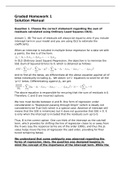Exam (elaborations)
MGT 6203 Graded Homework 1 Solutions.
- Course
- Institution
Graded Homework 1 Solution Manual Question 1. Choose the correct statement regarding the sum of residuals calculated using Ordinary Least Squares (OLS). Answer 1. (B) The sum of residuals will always be equal to zero if you include intercept term in your model and you are using OLS to estimate...
[Show more]



